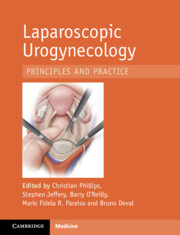94 results
Chapter 13 - Autosomal Dominant Polycystic Kidney Disease and Autosomal Recessive Polycystic Kidney Disease
- from Section 6 - Cystic Diseases
-
-
- Book:
- Pediatric Nephropathology & Childhood Kidney Tumors
- Published online:
- 10 August 2023
- Print publication:
- 09 March 2023, pp 255-271
-
- Chapter
- Export citation
Section 1: - Basic Principles in Laparoscopic Urogynaecology
-
- Book:
- Laparoscopic Urogynaecology
- Published online:
- 22 September 2022
- Print publication:
- 13 October 2022, pp 1-1
-
- Chapter
- Export citation
List of contributors
-
- Book:
- Laparoscopic Urogynaecology
- Published online:
- 22 September 2022
- Print publication:
- 13 October 2022, pp vii-viii
-
- Chapter
- Export citation
Section 3: - Opinion and Debate
-
- Book:
- Laparoscopic Urogynaecology
- Published online:
- 22 September 2022
- Print publication:
- 13 October 2022, pp 175-175
-
- Chapter
- Export citation
Frontmatter
-
- Book:
- Laparoscopic Urogynaecology
- Published online:
- 22 September 2022
- Print publication:
- 13 October 2022, pp i-iv
-
- Chapter
- Export citation
Section 2: - Procedureal Steps and Evidence
-
- Book:
- Laparoscopic Urogynaecology
- Published online:
- 22 September 2022
- Print publication:
- 13 October 2022, pp 85-85
-
- Chapter
- Export citation
Section 4: - Robotic Surgery
-
- Book:
- Laparoscopic Urogynaecology
- Published online:
- 22 September 2022
- Print publication:
- 13 October 2022, pp 221-221
-
- Chapter
- Export citation
Index
-
- Book:
- Laparoscopic Urogynaecology
- Published online:
- 22 September 2022
- Print publication:
- 13 October 2022, pp 246-252
-
- Chapter
- Export citation
Contents
-
- Book:
- Laparoscopic Urogynaecology
- Published online:
- 22 September 2022
- Print publication:
- 13 October 2022, pp v-vi
-
- Chapter
- Export citation

Laparoscopic Urogynaecology
- Principles and Practice
-
- Published online:
- 22 September 2022
- Print publication:
- 13 October 2022
Antibiotic stewardship to reduce inappropriate antibiotic prescribing in integrated academic health-system urgent care clinics
-
- Journal:
- Infection Control & Hospital Epidemiology / Volume 44 / Issue 5 / May 2023
- Published online by Cambridge University Press:
- 13 July 2022, pp. 736-745
- Print publication:
- May 2023
-
- Article
- Export citation
Psilocybin in neuropsychiatry: a review of its pharmacology, safety, and efficacy
-
- Journal:
- CNS Spectrums / Volume 28 / Issue 4 / August 2023
- Published online by Cambridge University Press:
- 11 July 2022, pp. 416-426
-
- Article
-
- You have access
- Open access
- HTML
- Export citation
Mortality After Total Anterior Circulation Stroke: A 25-Year Observational Study
-
- Journal:
- Canadian Journal of Neurological Sciences / Volume 50 / Issue 4 / July 2023
- Published online by Cambridge University Press:
- 20 June 2022, pp. 535-541
-
- Article
-
- You have access
- Open access
- HTML
- Export citation
Beyond Diagnose-and-Adios: Musings of a Retired Stroke Neurologist
-
- Journal:
- Canadian Journal of Neurological Sciences / Volume 50 / Issue 3 / May 2023
- Published online by Cambridge University Press:
- 25 April 2022, pp. 462-463
-
- Article
-
- You have access
- HTML
- Export citation
The Nanoscale Basis of Atrial Fibrillation: Functional Impact of Disrupting NaV1.5-rich Intercalated Disk Nanodomains.
-
- Journal:
- Microscopy and Microanalysis / Volume 26 / Issue S2 / August 2020
- Published online by Cambridge University Press:
- 30 July 2020, p. 832
- Print publication:
- August 2020
-
- Article
-
- You have access
- Export citation
Case–Control Study of Endovascular Thrombectomy in a Canadian Stroke Center
-
- Journal:
- Canadian Journal of Neurological Sciences / Volume 47 / Issue 1 / January 2020
- Published online by Cambridge University Press:
- 04 December 2019, pp. 44-49
-
- Article
-
- You have access
- HTML
- Export citation
A Cost-Utility Analysis of Endovascular Thrombectomy in a Real-World Setting
-
- Journal:
- Canadian Journal of Neurological Sciences / Volume 47 / Issue 1 / January 2020
- Published online by Cambridge University Press:
- 18 November 2019, pp. 50-60
-
- Article
-
- You have access
- HTML
- Export citation
Depressive psychopathology in first-episode schizophrenia spectrum disorders: a systematic review, meta-analysis and meta-regression
-
- Journal:
- Psychological Medicine / Volume 49 / Issue 15 / November 2019
- Published online by Cambridge University Press:
- 16 September 2019, pp. 2463-2474
-
- Article
- Export citation
Ethical Considerations in Multiple Pregnancy: Preterm Delivery in the Setting of Discordant Fetal Anomaly
-
- Journal:
- Twin Research and Human Genetics / Volume 22 / Issue 2 / April 2019
- Published online by Cambridge University Press:
- 26 April 2019, pp. 120-123
-
- Article
-
- You have access
- HTML
- Export citation
Expert Consensus on Screening and Assessment of Cognition in Psychiatry
-
- Journal:
- CNS Spectrums / Volume 24 / Issue 1 / February 2019
- Published online by Cambridge University Press:
- 15 January 2019, pp. 154-162
-
- Article
-
- You have access
- HTML
- Export citation



